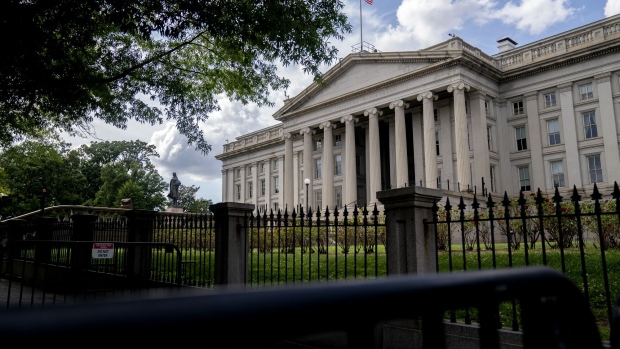Jan 29, 2024
US Treasury Cuts Quarterly Borrowing Estimate to $760 Billion
, Bloomberg News

(Bloomberg) -- The US Treasury reduced its estimate for federal borrowing for the current quarter, a move unexpected by many dealers, helping stoke rallies in bonds and stocks Monday.
The Treasury Department said that it now estimates $760 billion in net borrowing for January-through-March, down from a previous prediction of $816 billion released in late October. US debt managers kept their estimate for the Treasury’s cash balance for the end of March at $750 billion.
Treasuries hit their highs of the day after the release, with benchmark 10-year yields down about 7 basis points as of 3:30 p.m. in New York, at about 4.07%. The S&P 500 hit its high of the session, up 0.7% on the day.
“Because of the enormous debts and deficits being accumulated,” the Treasury’s announcements on borrowing plans are now market-moving events, Peter Boockvar, author of the Boock Report, wrote in a note Monday. The new borrowing estimate “has the Treasury market rallying and stocks following.”
The smaller borrowing need was driven by higher projected net fiscal flows, and having more cash on hand at the start of the quarter than expected, the department said in a statement. Treasury officials speaking with reporters declined to offer a breakdown on the improvement in fiscal flows relative to previous expectations.
Market Expectations
Many Wall Street strategists had anticipated a slight boost to the borrowing estimate, in part due to the fiscal deficit widening in recent months. Jay Barry, co-head of US rates strategy at JPMorgan Chase & Co., had predicted an $855 billion net borrowing figure for this quarter, assuming a $750 billion cash balance at the end of the period.
That wasn’t a universal view, however. Ira Jersey, chief US interest-rate strategist at Bloomberg Intelligence, was among those seeing a decline, and had forecast a net borrowing figure of about $700 billion.
While the Treasury is still facing rising costs to refinance its existing debt in wake of the Federal Reserve lifting its policy rate from near zero in 2022 to over 5%, yields tumbled over the past quarter as traders bet on a pivot to easing in 2024. A potential tapering, or end, of the Fed’s bond-portfolio runoff has also boosted sentiment — a shift that would also ease borrowing pressure on the Treasury.
The backdrop has most dealers expecting the Treasury on Wednesday to announce a final round of increases to note and bond sales, at its so-called quarterly refunding.
Read More: US Treasury Seen Boosting Long-Term Debt Sales One Last Time
The Treasury’s cash balance was about $830 billion as of Jan. 25, down slightly from about $838 billion on Oct. 30, when the department released its initial financing projections for the quarter.
For the April-to-June quarter, the Treasury on Monday said it expects to borrow a net $202 billion, with a cash balance of $750 billion seen for the end of the period.
Dealers warn that there’s much more uncertainty regarding financing estimates for the second quarter. Along with the Fed’s plans for its quantitative tightening program, another unknown is prospects for Congress enacting a $78 billion tax bill — which would worsen the deficit.
“The outlook for the Wyden-Smith tax bill is a major swing factor,” and at present we “flipped a coin and decided to assume that the legislation would not be approved,” Lou Crandall at Wrightson ICAP LLC said in a note before the Treasury’s Monday release. He penciled in $410 billion for net borrowing for the three months through June, ending with a $750 billion cash balance.
Read More: Why Quarterly Treasury Report Is Drawing More Notice: QuickTake
(Adds market reaction starting in first paragraph. An earlier version of this story corrected the historical cash balance description.)
©2024 Bloomberg L.P.






